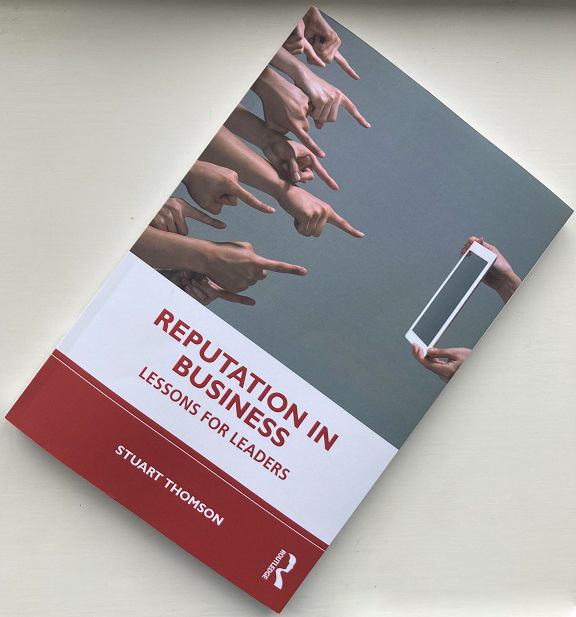Review: Reputation in Business

About the author
Richard Bailey Hon FCIPR is editor of PR Academy's PR Place Insights. He teaches and assesses undergraduate, postgraduate and professional students.

Reputation in Business: Lessons for Leaders
By Stuart Thomson
Routledge, 2023, 206 pages
For a profession that claims to be about reputation, it seems strange how little attention has been paid to this concept in the public relations academic and practitioner literature.
There’s the strong 2019 book by practitioner Tony Langham; there’s Waller and Younger’s The Reputation Game; there’s a classic US text by Doorley and Garcia and Andrew Griffin’s Crisis, Issues and Reputation Management. It’s been two decades since Fombrun and van Riel published Fame and Fortune: How Successful Companies Build Winning Reputations. It’s been ten years since Stephen Waddington and Steve Earl’s Brand Anarchy addressed the social media dimension. More recently, Sian Rees has explored the links between branding and reputation management, but for an audience of academics rather than practitioners.
So I welcome this new book by Stuart Thomson, a wise observer best known for his public affairs expertise. What he brings is a breadth of perspective and an approach tailored to leaders rather than public relations practitioners or students.
He states his approach early on in the book: ‘Reputation management is part of risk management’ and explains why he will be focusing on the political aspect of reputation management because ‘politicians are the audience that can do the most significant long-term damage to any organisation.’
Thomson also reminds us that politicians are a key stakeholder for all organisations, whether they operate in the private, public or third sectors. Customers by contrast are generally only relevant to commercial companies or the trading arms of charities.
So, his is a broad approach to reputation management that views the process, as does Andrew Griffin, as part of the risk and crisis management continuum.
This book is grounded in industry research and contemporary case studies rather than making reference to theories and concepts proposed by other authors (of those I’d mentioned above, only Waller & Younger are cited here).
The breadth of enquiry is impressive even if the lack of depth means there’s less value here for highly experienced practitioners or advanced students. Thomson’s audience, remember, comprises leaders of organisations. He demonstrates the risks facing them and outlines key approaches and lessons. In a section on social media, he recommends they follow Justin Trudeau’s approach to thought leadership on LinkedIn.
In the section on the media, Thomson makes the case for working with lawyers. (A case that was also forcefully made by Jonathan Coad in Reputation Matters, a book I left off the earlier list because of its narrow focus on handling the media in a crisis situation.) ‘Good lawyers understand the value of communications and reputation… They offer protection. They protect the organisation from future liabilities and think about regulatory impacts and requirements.’
Thomson ponders the paradoxes of the Volkswagen emissions cheating scandal, and asks how the company was able to recover so well from this. One intriguing thought is that it may have received less airtime because it was a difficult story to tell on the broadcast news: ‘One reason why VW may not have suffered in the public image quite so much as other companies could be down to the inability to convey visually a faked emissions test in a laboratory.’
The flip side of this is the reminder to less photogenic (or non consumer-facing) organisations that they will always face a struggle to tell their positive stories on television.
‘The language of reputation is the language of risk, how it is prioritised and the proactive actions taken to address it.’ Stuart Thomson
He’s such a sensible author. While observing that the chances of most company stories ‘going viral’ are ‘slim to zero’, he considers the opposite possibility. That ‘examples of poor behaviour can equally create viral content as well, causing its own reputational impacts.’
Given that most news is bad rather than good (don’t just blame cynical journalists for this, it’s evolutionary biology that makes us alert to any risks and dangers that can present threats to our survival), I’d suggest that the risk of a negative story spreading is greater than slim to zero. It certainly needs to be planned for.
There’s a strong and distinctive section on charities in this book. ‘Too often, reputation management is considered the preserve of corporates, but in reality, the stakeholder pressures on charities mean that reputation management is, or should be, at the top of their priority list.’
Thomson argues against the tendency to focus solely on the media in a crisis. ‘The real longer-term and lasting damage comes from the fallout with other stakeholders, especially politicians.’ In this context, the collapse of Kids Company is a telling case study.
Which leads us to politics (‘the role that politics plays is crucial in reputation management.’) Thomson reminds us that politicians are unlike other audiences leaders have to deal with – because they put themselves forward for election, so they’re very aware of their own reputations and public standing. He concludes this section with this warning: ‘unless you consider your reputation from a political perspective, you are failing to manage your risks effectively.’
This is a practical book, full of case studies that highlights key lessons for leaders. What it doesn’t do is explore first principles. You won’t find a discussion here of who manages reputation, or whether reputations can be measured.
Titles are tricky: the subtitle (‘Lessons for Leaders’) is a strong indication of the book’s focus, but ‘Reputation in Business’ implies a focus on commercial organisations and underplays the value in here for charity leaders and trustees.
But it’s a useful book that places reputation within the spectrum of risk, issues and crisis management – and which takes a distinctively political view of stakeholder relationship management.